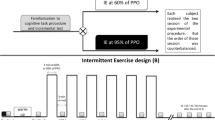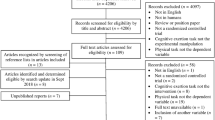Abstract
The effect of physical exercise on mental function has been widely studied from the beginning of the 20th century. However, the contradictory findings of experimental research have led authors to identify several methodological factors to control in such studies including: (i) the nature of the psychological task; and (ii) the intensity and duration of physical exercise. The purpose of this article is to provide information, from the perspective of performance optimisation, on the main effects of physical task characteristics on cognitive performance. Within this framework, some consistent results have been observed during the last decade. Recent studies, using mainly complex decisional tasks, have provided the research community with clear support for an improvement of cognitive performance during exercise. Diverse contributing factors have been suggested to enhance cognitive efficacy. First, an increase in arousal level related to physical exertion has been hypothesised. Improvement in decisional performance has been observed immediately after the adrenaline threshold during incremental exercise. Such positive effects could be enhanced by nutritional factors, such as carbohydrate or fluid ingestion, but did not seem to be influenced by the level of fitness. Second, the mediating role of resource allocation has been suggested to explain improvement in cognitive performance during exercise. This effect highlights the importance of motivational factors in such tasks. Finally, when the cognitive performance was performed during exercise, consistent results have indicated that the dual task effect was strongly related to energetic constraints of the task. The greater the energy demand, the more attention is used to control movements.





Similar content being viewed by others
Notes
Apositive effect size represents an impairment of performance (e.g. longer reaction time),while a negative effect size represents an improvement (e.g. shorter reaction time).
A fall in flicker threshold indicates CNS depression or psychic fatigue.[33]
Effective temperature (ET) and wet bulb globe temperature (WBGT) are global indices using dry temperature, relative humidity and air velocity.
References
Arcelin R. Interactions between physiological processes during acute aerobic exercise and mental functioning [PhD thesis]. Poitiers: University of Poitiers, 1999
Tomporowski PD, Ellis NR. Effects of exercise on cognitive process: a review. Psychol Bull 1986; 99: 338–46
Hogervorst E, Riedel W, Jeukendrup A, et al. Cognitive performance after strenuous physical exercise. Percept Mot Skills 1996; 83: 479–88
Hoshi Y, Tamura M. Detection of dynamic changes in cerebral oxygenation coupled to neuronal function during menta lwork in man. Neurosci Lett 1993; 150: 5–8
Isaacs LD, Pohlman EL. Effects of exercise intensity on an accompanying timing task. J Hum Mov Stud 1991; 20: 123–31
Chmura J, Krysztofiak H, Ziemba AW, et al. Psychomotor performance during prolonged exercise above and below the blood lactate threshold. Eur J Appl Physiol 1998; 77: 77–80
Brisswalter J, Durand D, Delignières D, et al. Optimal and nonoptimal demand in a dual task of pedalling and simple reaction time: effects on energy expenditure and cognitive performance. J Hum Mov Stud 1995; 29: 15–34
Abernethy B. Dual task methodology and motor skills research: some applications and methodological constraints. J Hum Mov Stud 1988; 14: 101–32
Arcelin R, Collardeau M, Brisswalter J. Choice reaction time and physical aerobic exercise intensity: a literature meta analysis. Percept Mot Skills. In press
Etnier JL, Salazar W, Landers DM, et al. The influence of physical fitness and exercise upon cognitive functioning: a meta analysis. J Sport Exerc 1997; 19: 249–77
Nougier V, Rossi B, Alain C, et al. Evidence of strategic effects in the modulation of orienting of attention. Ergonomics 1996; 39: 1119–33
Yerkes RM, Dodson JD. The relation of strength of stimulus to rapidity of habit-formation. J Comp Neurol Psychol 1908; 18: 459–82
Easterbrook JA. The effect of emotion on cue utilization and the organization of behavior. Psychol Rev 1959; 66: 183–201
Kubitz KA, Mott AA. EEG power spectral densities during and after cycle ergometer exercise. Res Q Exerc Sport 1996; 67: 91–6
Magnié MN, Bermon S, Martin F, et al. P300, N 400, aerobic fitness and maximal aerobic exercise. Psychophysiology 2000; 37: 1–9
Yagi Y, Coburn KL, Estes KM, et al. Effects of aerobic exercise and gender on visual and auditory P300, reaction time, and accuracy. Eur J Appl Physiol 1999; 80: 402–8
Reilly T, Smith D. Effect of work intensity on performance in a psychomotor task during exercise. Ergonomics 1986; 29: 601–6
Brisswalter J, Arcelin R, Audiffren M, et al. Influence of physical exercise on simple reaction time performance: effect of physical fitness. Percept Mot Skills 1997; 85 (3 Pt 1): 1019–27
Hughson RL, Green HJ, Sharrat MT. Gas exchange, blood lactate and plasma catecholamines during incremental exercise in hypoxia and normoxia. J Appl Physiol 1995; 79: 1134–41
Peronnet F, Szabo A. Sympathetic response to acute psychological stressors in humans: linkage to physical exercise and training. In: Seraganian P, editor. The influence of physical exercise on psychological processes. New York: J Wiley and Sons, 1993: 172–217
Clark CR, Geffen GM, Geffen LB. Catecholamines and the covert of attention in humans. Neuropsychology 1989; 27: 131–9
Greiwe JS, Hickner RC, Suresh DS, et al. Norepinephrine response to exercise at the same relative intensity before and after endurance training. J Appl Physiol 1999; 86: 531–5
Fery YA, Ferry A, Vom Hoffe A, et al. Effect of physical exhaustion on cognitive functioning. Percept Mot Skills 1997; 84: 291–8
McMorris T, Graydon J. The effect of exercise on cognitive performance in soccer specific test. J Sports Sci 1997; 15: 459–68
Arcelin R, Delignières D, Brisswalter J. Selective effects of physical exercise on choice reaction processes. Percept Mot Skills 1998; 87: 175–85
Sparrow WA, Wright BJ. Effect of physical exercise on the performance of cognitive tasks. Percept Mot Skills 1993; 77: 675–9
Brisswalter J, Legros P. Interaction between physiological and cognitive processes: theoretical and methodological problems. Sci Sports 1996; 11: 71–80
Emery CF, Leatherman NE, Burker EJ, et al. Psychological outcomes of a pulmonary rehabilitation program. Chest 1991; 100: 613–7
Blumenthal JA, Emery CF, Madden DJ, et al. Long-term effects of exercise on psychological functioning in older men and women. J Gerontol B Psychol Sci Soc Sci 1991; 46: 352–61
Polich J, Kok A. Cognitive and biological determinants of P300: an integrative review. Biol Psychol 1995; 41: 103–46
Brisswalter J, Hausswirth C, Smith D, et al. Energetically vs freely chosen cadence in triathlon: effect of exercise duration. Int J Sports Med 2000; 20: 60–4
Petruzzello SJ, Landers DM, Hatfield BD, et al. A meta-analysis on the anxiety-reducing effects of acute and chronic exercise. Sport Med 1991; 11: 143–82
Douchamp Riboux F, Heinz JM, Douchamp J. Arousal as a tridimensional variable: an exploratory study of behavioural changes in rowers following a marathon race. Int J Sport Psychol 1989; 20: 31–41
Collardeau M, Brisswalter J, Audiffren M. Effects of a prolonged run on simple reaction time in well trained. Percept Mot Skills 2001; 93: 679–89
Collardeau M, Brisswalter J, Vercruyssen F, et al. Cognitive performance during prolonged exercise in trained subjects: influence of carbohydrate availability. Eur J Appl Physiol 2001; 86: 150–6
Meeusen R, De Meirleir K. Exercise and brain neurotransmission. Sport Med 1995; 20: 160–88
Dustman RE, Emmerson RY, Shearer D. Physical activity, age, and cognitive neuropsychological function. J Aging Phys Activity 1994; 2: 143–81
Paas FG, Adam JJ. Human information processing during physical exercise. Ergonomics 1991; 34: 1385–97
Kahneman D. Attention and effort. Englewood Cliffs (NJ); Prentice-Hall, 1973
Hancock PA. Sustained attention under thermal stress. Psychol Bull 1986; 99: 263–81
Blomstrand E, Hassmen P, Ekblom B, et al. Administration of branched-chain amino acids during sustained exercise-effects on performance and on plasma concentration of some amino acids. Eur J Appl Physiol 1991; 63: 83–8
Walters TJ, Ryan KL, Tate LM, et al. Exercise in the heat is limited by a critical internal temperature. J Appl Physiol 2000; 89: 799–806
Holland RL, Sayers JA, Keatinge WR, et al. Effects of raised body temperature on reasoning, memory and mood. J Appl Physiol 1985; 59: 1823–7
Ramsey JD. Task performance in heat: a review. Ergonomics 1995; 38: 154–65
Gopinathan PM, Picham G, Sharma MA. Role of dehydration in stress induced variations in mental performance. Arch Environ Health 1988; 43: 15–7
Cian C, Koulmann N, Barraud PA, et al. Influence of variations in body hydration on cognitive function: effect of hyperhydra- tion, heat stress and exercise induces dehydration. J Psychophysiol 2000; 14: 29–36
Cian C, Barraud PA, Melin B, et al. Effects of fluid ingestion on cognitive function after heat stress or exercise-induced dehydration. Int J Psychophysiol 2001; 42: 243–51
Kirschbaum C, Wolf OT, May M, et al. Stress and treatment induced elevation of cortisol levels associated with impaired declarative memory in healthy adults. Life Sci 1996; 58: 1475–83
Davis JM. Nutritional influence on central mechanisms of fatigue involving serotonin. In: Maughan RJ, Shireffs SM, editors. Biochemistry of exercise IX. Leeds: Human Kinetics, 1996: 445–55
Pramming S, Thorsteinsson B, Theilgaard A, et al. Glycaemic threshold for changes in electroencephalogram during hypoglycaemia in patients with insulin dependent diabetes. BMJ 1988; 296: 665–7
Coyle EF. Timing and method of increased carbohydrate intake to cope with heavy training, competition and recovery. J Sports Sci 1991; 9: 29–52
Utter AC, Kang J, Nieman DC, et al. Effect of carbohydrate ingestion and hormonal responses on ratings of perceived exertion during prolonged cycling and running. Eur J Appl Physiol 1999; 61: 92–9
Reilly T, Lewis W. Effects of carbohydrate feeding on mental function during sustained physical work. In: Brown ID, Goldsmith R, Coombes K, et al., editors. Ergonomics international. London: Taylor and Francis, 1985: 700–2
Ivy JL, Miler W, Dover V, et al. Endurance improved by ingestion of a glucose polymer supplement. Med Sci Sports Exerc 1983; 15: 466–71
Davis JM, Bailey SP. Possible mechanisms of central nervous system fatigue during exercise. Med Sci Sports Exerc 1997; 29: 45–57
Delignières D, Brisswalter J, Legros P. Influence of physical exercise on choice reaction time in sports experts: the mediating role of resource allocation. J Hum Mov Stud 1994; 27: 173–88
Rejeski WJ. Perceived exertion: an active or passive process? J Sport Psychol 1985; 7: 371–8
Temprado JJ, Zanone P, Monno A, et al. Attentional load associated with performing and stabilizing preferred bimanuals patterns. J Exp Psychol Hum Percept Perform 1999; 25: 1579–94
Monno A, Chardenon A, Temprado JJ, et al. Effects of attention on phase transitions between bimanual coordination patterns: a behavioural and cost analysis in humans. Neurosci Lett 2000; 283: 93–6
Zanone PG, Monno A, Temprado JJ, et al. Shared dynamics of attention cost and pattern stability in the control of bimanual coordination. Hum Mov Sci 2001; 20: 765–89
Holt KG, Fonseca ST, Obusek JP. Dynamic and thermodynamic constraints and the metabolic cost of locomotion. In: Sparrow WA, editor. Energetics of human activity. Melbourne: Human Kinetics, 2000: 255–85
Kaneko M. Mechanics and energetics in running with special reference to efficiency. J Biomech 1990; 23: 57–63
Sajiki N, Moriai N, Isagoda A, et al. Reaction time during walking. Percept Mot Skills 1989; 69: 259–62
Author information
Authors and Affiliations
Corresponding author
Rights and permissions
About this article
Cite this article
Brisswalter, J., Collardeau, M. & René, A. Effects of Acute Physical Exercise Characteristics on Cognitive Performance. Sports Med 32, 555–566 (2002). https://doi.org/10.2165/00007256-200232090-00002
Published:
Issue Date:
DOI: https://doi.org/10.2165/00007256-200232090-00002




